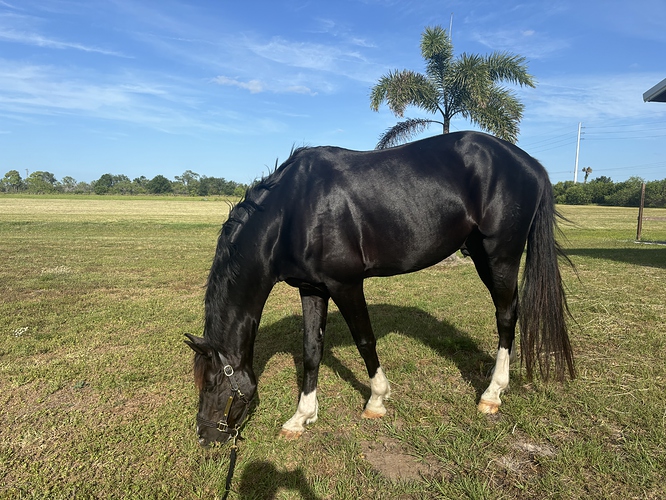Thank you for the replies! Both of my horses are on night turnout. The grass isn’t great right now because we’ve been in a drought. Their weights look good overall, maybe my smaller horse could gain a little more weight.
Their feeding is a little confusing because they came from two different barns with completely different routines. My bigger mare was on a grain-free feed, while my smaller gelding was at a show barn where all the horses were on a feed called Guidolin from Italy. It looks like hay cubes, but it’s a complete feed—no grain or hay necessary. They’re fed three times a day, and honestly, every horse I’ve seen on it looked amazing and maintained a healthy weight—many even on the heavier side. These were high-performance Grand Prix jumpers in heavy work, and they thrived on it.
My gelding was on that feed for the past two years with no issues, and given that he had colic surgery a few years prior, I was nervous to take him off something that had been working so well. When I brought both horses home, I planned to put my mare on Guidolin too. The company and the Wellington barn both said they’d never had a horse refuse it—but my mare, who’s always been picky, ended up being the first. She wouldn’t eat it at all.
The grain-free feed she was originally on wasn’t something I could get right away, so I asked my local feed store which senior feed they recommended most, and they suggested Seminole Wellness Senior. I remembered she had done well on Seminole years ago, so I started her on that.
As for my gelding, my new trainer was skeptical about the Guidolin feed. She believes every horse should be on hay and grain, and she also worried it might be too high-energy for him as a hunter (whereas the horses at the show barn were all high-level jumpers). I wasn’t really concerned about energy since he was always pretty lazy on it, but I decided to transition him over to grain and hay so both horses were on a similar routine. He’s now on Purina Senior.
A week into the switch, he choked for the first time. I think it was because he was used to chewing the cubes, and now he bolts his food. I began soaking his grain, and the issue stopped—except for one time when I thought he would be okay to try without soaking since he was fully switched over and doing well, and he choked again. So now we always soak his grain.
They’re both on O/A hay because my mare was on it previously and liked it, and I didn’t know what hay my gelding would do best on after two years off hay. They seem to like the o/a.
I’m honestly not sure if I’m feeding them correctly, and my biggest worry is that I’m not feeding enough. For my mare, I asked the previous barn owner how much Seminole to feed, and she suggested 1.5 3-quart scoops per feeding. My trainer thought that sounded like a lot but said if her weight looked good and she was eating it well, it should be okay. I ended up settling at 4 quarts twice a day.
My gelding was at 2 quarts twice a day after transitioning, but I just increased him to 3 quarts twice a day this week because I wasn’t sure if 2 was enough. On the Guidolin feed, he was getting 7 full 3-quart scoops per day.
Looking back, I wonder if I should’ve kept him on the Guidolin. He did great on it, I knew exactly how much to feed, and his weight was perfect. Plus, it made things easier for my dad—he liked that there was no hay to store or waste, and it was less expensive. Before, we were spending about $480/month for both horses on Guidolin (no hay). Now with grain and hay, we’re spending around $1,000/month—more than double—which my dad’s understandably frustrated about. It still wouldn’t have worked it for my mare though since she wouldn’t eat it.
Right now, they each get 2 flakes in the morning and evening, plus a lunch feeding where my gelding gets 1 flake and my mare gets 2. We’re going through about 1 bale of hay per day, and each bale is $22—so about $660/month just on hay, not including grain.
I also feel like they could both use more hay. They eat it so fast that if I wanted them to have hay in front of them all the time, I’d need to be tossing them each a couple of flakes every hour. I really want to make sure I’m doing the right thing for them.
This is my first time being totally in charge of my horses and I just want to make sure I’m doing everything right by them and just want to know how much I should actually be feeding them grain and hay wise to meet their nutritional needs and keep them healthy and happy.



